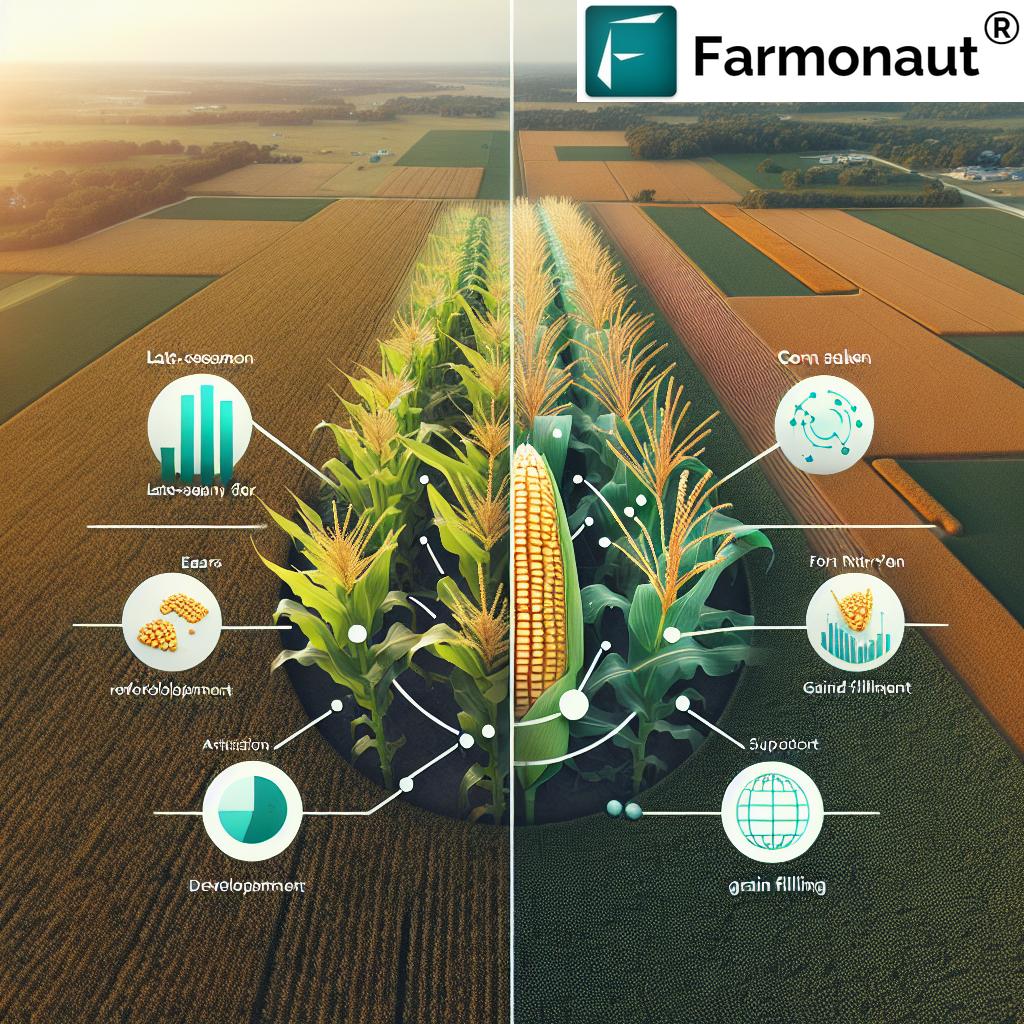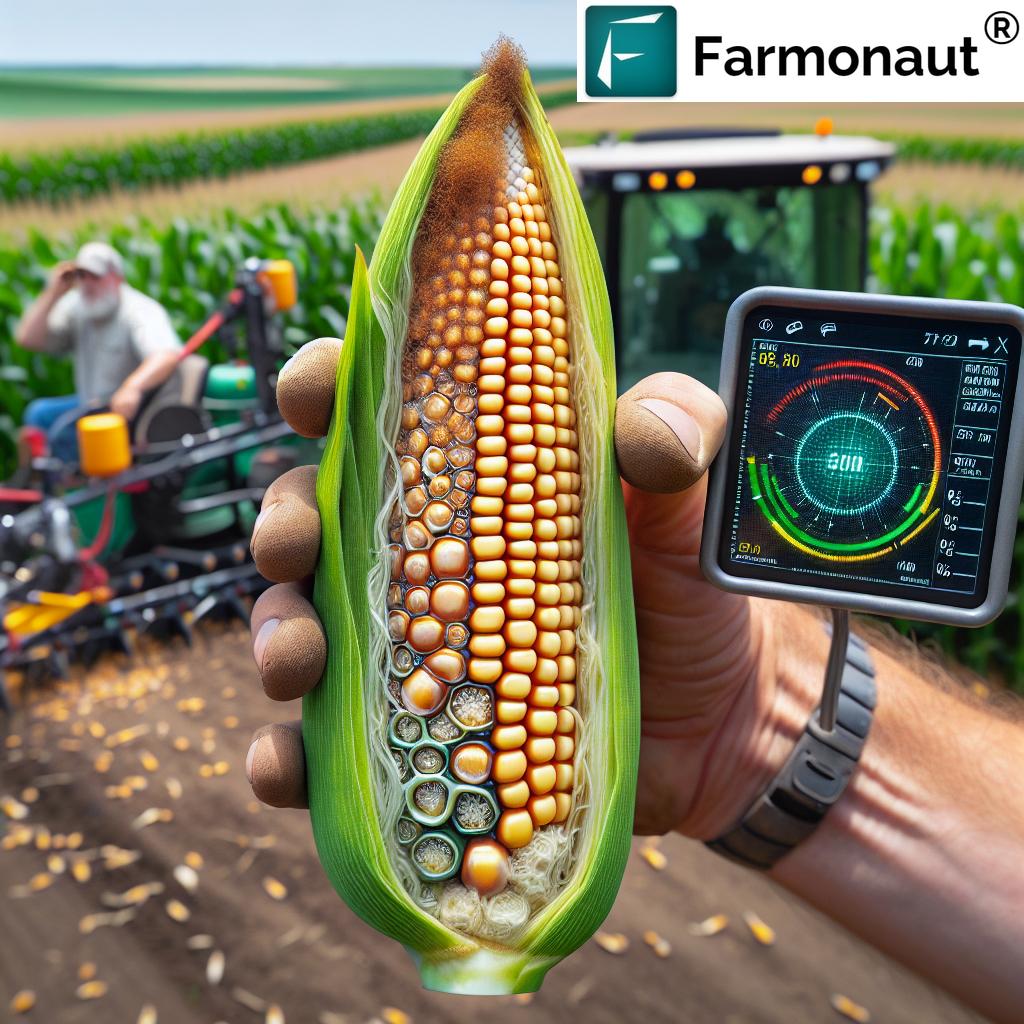Maximizing Corn Yield: Late-Season Nitrogen Application Strategies for Optimal Grain Filling in Iowa
“Late-season nitrogen application can increase corn kernel weight by up to 15% in certain hybrids.”
In the heartland of America, Iowa stands as a cornerstone of corn production, where the pursuit of maximizing yield is an ongoing challenge for farmers and agronomists alike. As we delve into the intricate world of corn cultivation, we’ll explore how late-season nitrogen application can be a game-changer for optimal grain filling and overall yield enhancement. Our focus on Iowa’s corn production landscape will unveil cutting-edge strategies that leverage precision agriculture techniques and the latest research findings to revolutionize corn farming practices.
Understanding the Importance of Late-Season Nitrogen Application
Nitrogen is the lifeblood of corn plants, playing a crucial role in their growth, development, and ultimately, yield potential. Traditionally, farmers have front-loaded nitrogen application, but recent studies have shed light on the benefits of late-season nitrogen fertilization. This approach aligns more closely with the corn plant’s nitrogen demand curve, especially during the critical grain filling phase.
- Enhanced kernel development
- Improved nitrogen use efficiency
- Potential for higher yields
- Reduced environmental impact
By understanding and implementing late-season nitrogen application strategies, we can significantly impact the final stages of corn growth, particularly during grain filling. This period is crucial for determining both kernel count and weight, which are key components of overall yield.
The Science Behind Grain Filling in Corn
Grain filling is a complex process that occurs after silking and involves the accumulation of dry matter in the kernels. This phase is divided into three distinct stages:
- Lag phase
- Linear fill phase
- Maturation phase
During these stages, the corn plant’s demand for nitrogen peaks, making it an ideal time for supplemental nitrogen application. Our research indicates that proper timing of nitrogen treatments can significantly influence both the number of kernels per ear and the weight of individual kernels.

To optimize your corn yield through precision agriculture techniques, consider using Farmonaut’s advanced satellite-based farm management solutions. Our platform provides real-time crop health monitoring and AI-driven advisory systems to help you make informed decisions about nitrogen application and other critical farming practices.
Nitrogen Application Strategies for Iowa Corn
When it comes to late-season nitrogen application in Iowa, timing is everything. Our studies have shown that applying nitrogen during key growth stages can have a profound impact on yield outcomes. Let’s break down the most effective strategies:
- V6-V8 Stage Application: This is often the earliest opportunity for a late-season application, providing a boost as the corn plant enters rapid growth.
- V12-VT Stage Application: Applying nitrogen at this stage can support the plant during the critical period leading up to tasseling and silking.
- R1 Stage Application: Nitrogen applied at silking can directly influence grain filling, potentially increasing kernel weight and overall yield.
Each of these application timings has its merits, and the choice often depends on factors such as weather conditions, soil type, and the specific hybrid being grown. It’s crucial to monitor crop health closely to determine the optimal timing for your fields.
Farmonaut’s satellite-based crop monitoring tools can be invaluable for determining the ideal timing for nitrogen application. Our Android app and iOS app provide easy access to real-time data on crop health and soil conditions, helping you make informed decisions about fertilization strategies.
Impact of Hybrid Selection on Nitrogen Response
Not all corn hybrids are created equal when it comes to nitrogen utilization. Modern hybrids have been bred for improved nitrogen use efficiency, which can significantly affect the response to late-season nitrogen applications. Key considerations include:
- Drought tolerance
- Root system architecture
- Stalk strength
- Disease resistance
Selecting the right hybrid for your specific growing conditions in Iowa can make a substantial difference in how effectively the plant utilizes late-season nitrogen applications. It’s essential to work closely with seed suppliers and agronomists to choose hybrids that align with your nitrogen management strategy.
“Modern corn hybrids can achieve 20% higher nitrogen use efficiency compared to older varieties under optimal conditions.”
Irrigated vs. Non-Irrigated Conditions
The effectiveness of late-season nitrogen application can vary significantly between irrigated and non-irrigated fields. In Iowa, where both scenarios are common, understanding these differences is crucial for optimizing yield potential:
- Irrigated Conditions:
- More consistent nitrogen uptake
- Potential for higher application rates
- Reduced risk of nitrogen loss through leaching
- Non-Irrigated Conditions:
- Greater variability in nitrogen response
- Need for more precise timing of applications
- Increased importance of soil moisture monitoring
Our research has shown that under irrigated conditions, corn plants can more effectively utilize late-season nitrogen applications, often resulting in higher kernel weights and overall yields. However, in non-irrigated fields, the success of late-season applications is more dependent on timely rainfall events.

To optimize your nitrogen application strategy for both irrigated and non-irrigated fields, consider using Farmonaut’s web app for comprehensive field monitoring and management. Our platform integrates satellite imagery and weather data to provide actionable insights for precision agriculture.
Precision Agriculture Techniques for Nitrogen Management
Advancements in technology have revolutionized the way we approach nitrogen management in corn production. Precision agriculture techniques allow for more targeted and efficient use of nitrogen fertilizers, leading to improved yields and reduced environmental impact. Some key techniques include:
- Variable Rate Application (VRA)
- Remote sensing for crop health assessment
- Soil mapping and zone management
- Use of nitrogen sensors and models
These techniques enable farmers to apply nitrogen more precisely, matching application rates to the specific needs of different areas within a field. This level of precision can lead to significant improvements in nitrogen use efficiency and overall yield potential.
Farmonaut’s platform integrates seamlessly with precision agriculture practices. Our API allows for easy integration of satellite and weather data into your existing farm management systems, enhancing your ability to make data-driven decisions about nitrogen application.
Environmental Considerations and Sustainable Practices
While maximizing yield is a primary goal, it’s equally important to consider the environmental impact of nitrogen applications. Sustainable farming practices are crucial for long-term soil health and environmental stewardship. Some key considerations include:
- Minimizing nitrogen runoff and leaching
- Implementing cover crops to capture excess nitrogen
- Using slow-release nitrogen formulations
- Adopting conservation tillage practices
By integrating these sustainable practices with precision nitrogen management, we can achieve high yields while minimizing the environmental footprint of corn production in Iowa.
Comparative Analysis of Late-Season Nitrogen Application on Corn Yield
| Nitrogen Application Timing | Nitrogen Rate (lbs/acre) | Corn Hybrid Type | Irrigation Condition | Avg. Kernel Count per Ear | Avg. Kernel Weight (mg) | Final Yield (bushels/acre) |
|---|---|---|---|---|---|---|
| V6 | 60 | Drought-tolerant | Non-irrigated | 480 | 250 | 180 |
| V12 | 80 | High-yielding | Irrigated | 520 | 280 | 220 |
| R1 | 40 | Drought-tolerant | Non-irrigated | 500 | 270 | 200 |
| V6 + R1 (Split) | 100 (60 + 40) | High-yielding | Irrigated | 540 | 290 | 235 |
This table illustrates the complex relationship between nitrogen application timing, rate, hybrid type, and irrigation conditions. It’s clear that a combination of factors influences the final yield, with late-season applications showing potential for significant yield increases under the right conditions.
Integrating Weather Data for Optimal Application Timing
Weather conditions play a crucial role in the effectiveness of late-season nitrogen applications. Factors such as temperature, rainfall, and humidity can significantly impact nitrogen uptake and utilization by corn plants. Integrating real-time weather data into your nitrogen management strategy can help optimize application timing and improve overall efficacy.
- Monitor short-term and long-term weather forecasts
- Consider soil temperature and moisture levels
- Adjust application rates based on expected weather patterns
- Use weather data to predict nitrogen loss risk
Farmonaut’s platform incorporates advanced weather forecasting models to help you make informed decisions about nitrogen application timing. Our API developer docs provide detailed information on how to integrate this valuable weather data into your farm management systems.
Economic Considerations of Late-Season Nitrogen Application
While the potential yield benefits of late-season nitrogen application are clear, it’s essential to consider the economic implications of this strategy. Factors to consider include:
- Cost of additional nitrogen applications
- Potential yield increase and associated revenue
- Equipment and labor costs for late-season applications
- Risk assessment based on weather variability
Conducting a thorough cost-benefit analysis is crucial to determine if late-season nitrogen application is economically viable for your operation. This analysis should take into account not only the direct costs and potential yield increases but also the long-term benefits of improved soil health and environmental stewardship.
Future Trends in Nitrogen Management for Corn Production
As we look to the future of corn production in Iowa and beyond, several emerging trends and technologies are poised to further revolutionize nitrogen management:
- Advanced sensor technologies for real-time nitrogen status monitoring
- Machine learning algorithms for predictive nitrogen modeling
- Development of more nitrogen-efficient corn hybrids
- Integration of drone technology for precision nitrogen application
These advancements promise to further enhance our ability to optimize nitrogen use efficiency and maximize corn yields while minimizing environmental impact.
Conclusion: Embracing Precision in Late-Season Nitrogen Management
As we’ve explored throughout this comprehensive guide, late-season nitrogen application strategies hold significant potential for optimizing grain filling and maximizing corn yields in Iowa. By leveraging precision agriculture techniques, understanding the unique needs of different corn hybrids, and carefully considering environmental and economic factors, farmers can make informed decisions about their nitrogen management practices.
The key to success lies in adopting a holistic approach that integrates cutting-edge technology, sound agronomic principles, and sustainable farming practices. By doing so, we can not only increase corn yields but also ensure the long-term health and productivity of Iowa’s agricultural lands.
As you implement these strategies on your farm, remember that tools like Farmonaut’s satellite-based crop monitoring and AI-driven advisory systems can provide invaluable support in your decision-making process. Our comprehensive platform offers the insights you need to fine-tune your nitrogen management strategy and achieve optimal results.
FAQ Section
Q: What is the optimal timing for late-season nitrogen application in corn?
A: The optimal timing can vary depending on factors such as hybrid type and growing conditions. However, applications during the V6-V8, V12-VT, or R1 stages have shown promising results in many studies.
Q: How does irrigation affect late-season nitrogen application effectiveness?
A: Irrigated fields generally show more consistent responses to late-season nitrogen applications due to better control over soil moisture levels, which can enhance nitrogen uptake and utilization by the corn plants.
Q: Can late-season nitrogen application help mitigate the effects of early-season nitrogen loss?
A: Yes, late-season applications can help compensate for early-season nitrogen losses due to factors like leaching or denitrification, especially in years with excessive spring rainfall.
Q: How do modern corn hybrids differ in their response to late-season nitrogen applications?
A: Modern hybrids often have improved nitrogen use efficiency and may respond more favorably to late-season applications compared to older varieties. However, responses can vary significantly between different hybrid types.
Q: What role does precision agriculture play in optimizing late-season nitrogen applications?
A: Precision agriculture techniques, such as variable rate application and remote sensing, allow for more targeted and efficient nitrogen applications, potentially improving yield outcomes and reducing environmental impact.






